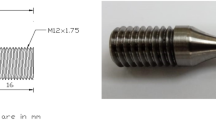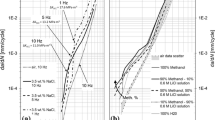Abstract
The present study compares the fatigue and fracture properties of the high-strength β titanium alloy β-Cez with the conventional α+β titanium alloy Ti-6Al-4V, because of increasing interest in replacing α+β titanium alloys with β titanium alloys for highly stressed airframe and jet engine components. This comparison study includes the Ti-6Al-4V alloy in an α+ β-processed condition (for a typical turbine blade application) and the β-Cez alloy in two distinctly different α+β-processed and β-processed conditions (optimized for a combination of superior strength, ductility, and fracture toughness). The comparison principally showed a much lower yield stress for Ti-6Al-4V (915 MPa) than for both β-Cez conditions (1200 MPa). The Ti-6Al-4V material also showed the significantly lower high-cycle fatigue strength (resistance against crack initiation) of 375 MPa (R=−1) as compared to the β-Cez alloy (∼600 MPa, R=−1). Particularly in the presence of large cracks (>5 mm), the fatigue crack growth resistance and fracture toughness of the Ti-6Al-4V material is superior when compared to both β-Cez conditions. However, for small crack sizes, the conditions of both the alloys under study show equivalent resistance against fatigue crack growth. For the β-Cez material, where microstructures were optimized for high fracture toughness (conventional large crack sizes) by thermomechanical processing, maximum K Ic-values of 68 MPa√m of the β-processed β-Cez condition (tested in the longitudinal direction) decreased by ∼50 pct in the presence of small cracks (1 mm). A similar decrease in fracture toughness was obtained by loading the β-processed β-Cez condition perpendicular to the flat surfaces of the pancake-shaped β grain structure (tested in the short transverse direction). These results were discussed in terms of the effectiveness of the crack front geometry in hindering crack propagation. Further, the results of this study were considered for alloy selection and optimized microstructures for fatigue and fracture critical applications. Finally, the advantage of the α+β-processed β-Cez condition in highly stressed engineering components is pointed out because of its overall superior combination of fatigue crack initiation and propagation resistance (especially against small fatigue cracks).
Similar content being viewed by others
References
Beta Titanium Alloys in the 80’s, R.R. Boyer and H.W. Rosenberg, eds., AIME, Warrendale, PA, 1984.
Beta Titanium Alloys in the 1990’s, D. Eylon, R.R. Boyer, and D.A. Koss, eds., TMS, Warrendale, PA, 1993.
Beta Titanium Alloys, A. Vassel, D. Eylon, and Y. Combres, eds., Editions de la Revue de Métallurgie, Paris, 1994.
T.K. Redden: in Beta Titanium Alloys in the 80’s. R.R. Boyer and H.W. Rosenberg, eds., AIME, Warrendale, PA, 1984, pp. 239–54.
H.W. Rosenberg: in Beta Titanium Alloys in the 80’s, R.R. Boyer and H.W. Rosenberg, eds., AIME, Warrendale, PA, 1984, pp. 433–39.
J.C. Williams: Mater. Sci. Eng. A, 1999, vol. A263, pp. 107–11.
S.M. Russ: Proc. 5th Nat. Turbine Engine HCF Conf., CD Rom, Session 7, Materials Damage Tolerance III, AFRL/PRT, Wright-Patterson AFB, OH, 2000, pp. 45–53.
R.R. Boyer: Mater. Sci. Eng. A, 1996, vol. A213, pp. 103–14.
D. Eylon: “Summary of the Available Information on the Processing of the Ti-6Al-4V HCF/LCF Program Plates,” University of Dayton Report, Dayton, OH, 1998.
B. Prandi, E. Alheritiere, F. Schwartz, and M. Thomas: Proc. 6th World Conference on Titanium, P. Lacombe, R. Tricot, and G. Beranger, eds., 1988, pp. 811–18.
Y. Combres and B. Champin: in Beta Titanium Alloys in the 1990’s, D. Eylon, R.R. Boyer, and D.A. Koss, eds., TMS, Warrendale, PA, 1993, pp. 27–38.
in Metals Properties Handbook: Titanium Alloys, R.R. Boyer, G. Welsch, and E.W. Collings, eds., ASM INTERNATIONAL, Materials Park, OH, 1994, pp. 931–34.
R.O. Ritchie and J. Lankford: Mater. Sci. Eng., 1986, vol. 84, pp. 11–16.
M.A. Hicks and A.C. Pickard: Mater. Sci. Eng. A, 1988, vol. A103, pp. 43–48.
B. Wiltshire and J.F. Knott: Int J. Fracture, 1980, vol. 16, pp. R19-R26.
G. Lütjering, J.O. Peters, and J. Albrecht: Int. Symp. on designing, Processing and Properties of Advanced Engineering Materials, JSPS AEM 156, Tokyo, 1997, pp. 56–67.
D.F. Horne: Aircraft Production Technology, Cambridge University Press, Cambridge, United Kingdom, 1986.
D. Helm: in Fatigue Behavior of Titanium Alloys, R.R. Boyer, D. Eylon, and G. Lütjering, eds., TMS, Warrendale, PA, 1999, pp. 291–98.
J.C. Williams: in High Performance Materials in Aerospace, H.M. Flower, ed., Chapman & Hall, London, 1995, pp. 105–23.
P.E. Mosser, N. Marnier, and Y. Honorat: Titanium ’92, Science and Technology, Proc. 7th World Conf. on Titanium, F.H. Froes and J. Caplan, eds., TMS, Warrendale, PA, 1993, pp. 1338–46.
P.J. Bania: in Beta Titanium Alloys in the 1990’s, D. Eylon, R.R. Boyer, and D.A. Koss, eds., TMS, Warrendale, PA, 1993, pp. 3–14.
Y. Combres and B. Champin: Mater. Tech., 1991, pp. 31–41.
J.O. Peters, G. Lütjering, M. Koren, H. Puschnik, and R.R. Boyer: Mater. Sci. Eng. A, 1996, vol. A213, pp. 71–80.
J.O. Peters, G. Lütjering, M. Koren, H. Puschnik, and R.R. Boyer: in Advances in the Science and Technology of Titanium Alloy Processing, TMS, Warrendale, PA, 1997, pp. 379–86.
J.C. Williams and G. Lütjering: in Titanium ’80, Science and Technology, H. Kimura and O. Izumi, eds., TMS-AIME, Warrendale, PA, 1980, vol. 1, pp. 671–81.
M. Peters and G. Lütjering: Z. Metallkd., 1976, vol. 67 (H12), pp. 811–14.
M. Niinomi and T. Kobayashi: Mater. Sci. Eng. A, 1996, vol. A213, pp. 16–24.
J.A. Hines, J.O. Peters, and G. Lütjering: in Fatigue Behavior of Titanium Alloys, R.R. Boyer, D. Eylon, and G. Lütjering, eds., TMS, Warrendale, PA, 1999, pp. 15–22.
S. Suresh and R.O. Ritchie: Int. Met. Rev., 1984, vol. 29 (6), pp. 445–76.
R.P. Gangloff and R.O. Ritchie: Fundamentals of Deformation and Fracture, Eshelby Memorial Symp., B.A. Bilby, K.J. Miller, and J.R. Willis, eds., Cambridge University Press, Cambridge, United Kingdom, 1985, pp. 529–58.
The Behaviour of Short Fatigue Cracks, K.J. Miller and E.R. de los Rios, eds., Mechanical Engineering Publ., London, 1986.
Small Fatigue Cracks, R.O. Ritchie and J. Lankford, eds., TMS-AIME, Warrendale, PA, 1986.
Small Fatigue Cracks: Mechanics, Mechanisms and Applications, K.S. Ravichandran, R.O. Ritchie, and Y. Murakami, eds., Elsevier, Oxford, United Kingdom, 1999.
J.O. Peters, O. Roder, B.L. Boyce, A.W. Thompson, and R.O. Ritchie: Metall. Mater. Trans. A, 2000, vol. 31A, pp. 1571–83.
R.O. Ritchie and J.O. Peters: Mater. Trans., JIM, Japan Institute of Metals, Tokyo, Japan, 2001, [vol. 42 (1)], pp. 58–67.
J.C. Newman and I.S. Raju: Eng. Fract. Mech., 1981, vol. 15, pp. 185–92.
R.O. Ritchie: Mater. Sci. Eng. A, 1988, vol. A103, pp. 15–28.
G. Lütjering, A. Gysler, and L. Wagner: Proc. 6th World Conf. Titanium, P. Lacombe, R. Tricot, and G. Beranger, eds., 1988, Les éditions de physiques, Les Ulis, Cedex, France, pp. 71–80.
S. Suresh: Metall. Trans. A, 1983, vol. 14A, pp. 1983–2375.
J.O. Peters and G. Lütjering: Z. Metallkd., 1998, vol. 89, pp. 464–73.
G. Terlinde and G. Fischer: Titanium ’95: Science and Technology, Proc. 8th World Conf. on Titanium, P.A. Blenkinsop, W.J. Evans, and H.M. Flower, eds., The Institute of Materials, London, 1996, pp. 2177–94.
T.W. Duerig and J.C. Williams: in Beta Titanium Alloys in the 80’s, R.R. Boyer and H.W. Rosenberg, eds., AIME, Warrendale, PA, 1984, pp. 19–67.
T.W. Duerig, J.E. Allison, and J.C. Williams: Metall. Trans. A, 1985, vol. 16A, pp. 739–51.
F.A. McClintock and G.R. Irwin: Fracture Toughness Testing and Its Applications, ASTM STP 381, ASTM, Philadelphia, PA, 1965, pp. 84–113.
R.O. Ritchie: Met. Sci., 1977, vol. 11, pp. 368–81.
I. Altenberger, J.M. McNaney, J.O. Peters, and R.O. Ritchie: University of California at Berkeley, Berkeley, CA, unpublished research, 2000.
M. Shiratori, T. Miyoshi, Y. Sakai, and G.R. Zhang: in Stress Intensity Factors Handbook, Y. Murakami, ed, Pergamon Press, New York, NY, 1987, pp. 659–65.
R. Sanguinetti and E. Gautier: in Beta Titanium Alloys, A. Vassel, D. Eylon, and Y. Combres, eds., Editions de la Revue de Métallurgie, Paris, 1994, pp. 93–100.
E. Gautier and D. Delannoy: in Beta Titanium Alloys, A. Vassel, D. Eylon, and Y. Combres, eds., Editions de la Revue de Métallurgie, Paris, 1994, pp. 49–56.
A.-M. Chaze and F. Montheillet: in Beta Titanium Alloys, A. Vassel, D. Eylon, and Y. Combres, eds., Editions de la Revue de Métallurgie, Paris, 1994, pp. 41–48.
J.O. Peters and R.O. Ritchie: Eng. Fract. Mech., 2000, vol. 67, pp. 193–207.
Author information
Authors and Affiliations
Rights and permissions
About this article
Cite this article
Peters, J.O., Lütjering, G. Comparison of the fatigue and fracture of α+β and β titanium alloys. Metall Mater Trans A 32, 2805–2818 (2001). https://doi.org/10.1007/s11661-001-1031-8
Received:
Issue Date:
DOI: https://doi.org/10.1007/s11661-001-1031-8




